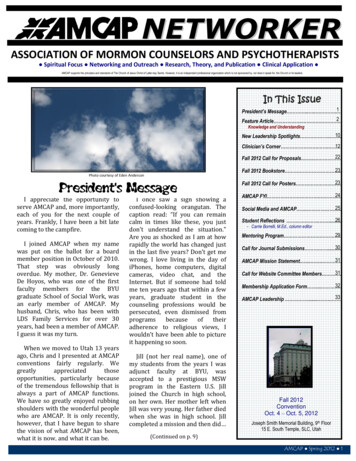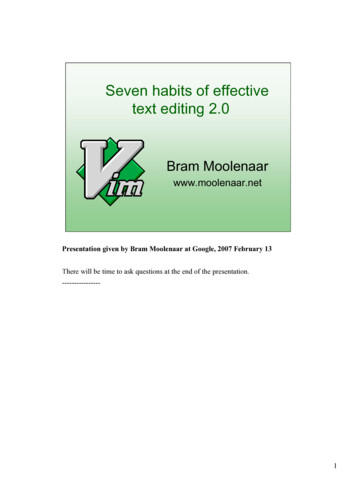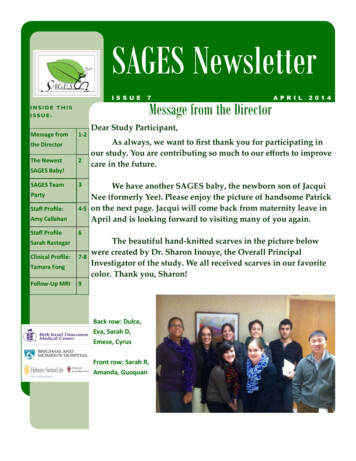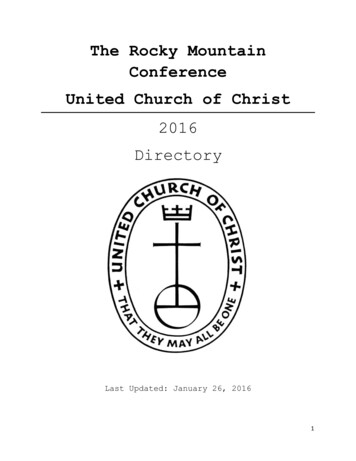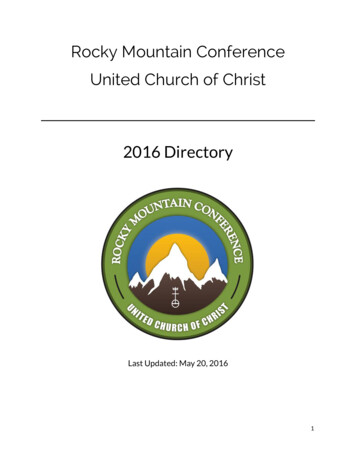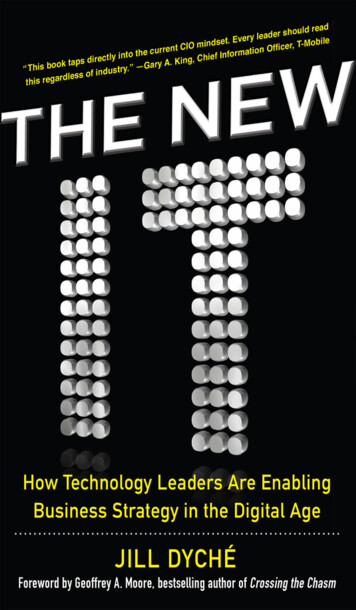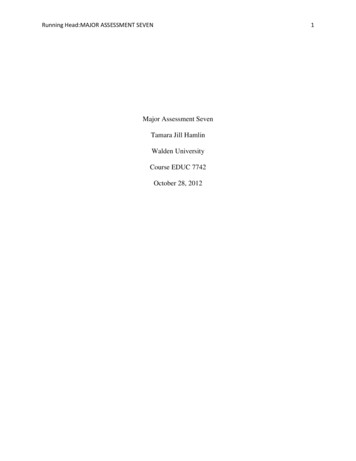
Transcription
Running Head:MAJOR ASSESSMENT SEVEN1Major Assessment SevenTamara Jill HamlinWalden UniversityCourse EDUC 7742October 28, 2012
MAJOR ASSESSMENT SEVEN2Major Assessment SevenIntroductionCollaboration is the cornerstone of high quality professional development. Teacherscollaborate in order to create something greater than they could do alone; Killion and Roy callthis “sharing leadership” (2009, p. 130). Collaborative practices bring educators together to workand plan and assess. Collaboration can help teachers refine their lessons or find new activities fortheir students, it “benefits its participants, it benefits the school” (Killion, 2009, p. 469).This candidate collaborates on a regular basis. Specifically, she has repeatedlycollaborated in the course of her Walden coursework, thus fulfilling the requirements of WaldenUniversity’s PEU 5 on Collaboration. “This candidate demonstrates collaborative skills thatintegrate multiple perspectives in order to create ongoing support for the learning” (WaldenUniversity catalog, 2012).Collaboration 1During Walden course 7740, “Qualities of Effective Professional Development”, thiscandidate formalized a professional learning community (PLC) with her fellow eighth gradesocial studies teachers. The group had been meeting regularly for several months, but thiscandidate was able to strategize for more effective collaboration using materials from herWalden coursework. PLCs are a good vehicle for curricular improvement for many reasons. In aPLC, teachers with the best results help direct the instructional strategies for the whole group.PLCs support teachers by providing the context for discourse and collaboration.The social studies PLC members including this candidate learned many new things aboutcollaboration during the spring of 2012. Members compared assessment data; effective datacomparisons also fulfill NCATE standard 1e which requires teachers to “collect and analyze data
MAJOR ASSESSMENT SEVEN3related to their work and reflect on their practices” (NCATE, 2008, p. 19). Appendix Adocuments a data discussion where teachers compare data in order to improve instructionalpractices. Throughout the collaborative process, members invested in their mutual trust andtreated each other with professionalism in order to make the PLC work. This professionallearning group has helped this candidate grow professionally through its collaborative and teamoriented practices. Appendix B depicts another artifact of the PLC, a draft assessment with groupmember’s notes along the margins. Working together, this candidate and her colleagues havebeen able to increase the rigor on assessments which has in turn increased the rigor ofinstruction.The collaboration also addressed learning forward’s data standard which demands thateducators use data in their professional planning and collaboration to set goals for students andplan instruction (Learning forward, 2012). One of the most difficult tasks for a teacher is tocompare results with other teachers because numbers comparisons can exacerbate competitivetensions (see Appendix A for data comparison). This collaborative team met this challenge byembracing prescribed professional standards. Collaborative group norms help in “navigating thetensions,” and help each PLC member grow professionally while providing an enhanced learningenvironment in their classroom (Garmston & Wellman, 2009, p. 27). The trust between PLCmembers helps boost the academic rigor and success in the classroom through improvedinstructional strategies and data usage.Collaboration 2Again during Walden course 7740, this candidate had other opportunities to collaboratewith her colleagues at work. Creating a positive climate is key element of a successfulprofessional learning session. Varied instructional strategies within professional learning
MAJOR ASSESSMENT SEVEN4sessions as well as safe, supportive educational environments are hallmarks of a good climate.This candidate brought a practical instructional strategy introduced in professional literature tothe meetings. The “Assumptions Wall” (see Appendix C) allows participants to strategizetogether by airing their dirty laundry which in this case are the assumptions teachers have abouttheir students (Garmston & Wellman, 2009, p. 189). The team created this wall in a breakoutsession during a professional development meeting in March 2012 (see Appendix D for meetingagenda).PLC members brainstorm their own assumptions about student failure. This candidatethen modeled a line of questioning about those assumptions and a discussion ensued. Participantsclassified different assumptions and all participants were engaged in the discussion. This strategyhelped teachers dig into their own preconceived notions about testing as well as discuss theirideas with others. It can be a challenge for teachers to face their own assumptions and work withthe notion that their preconceived notions could affect the learning outcomes of their students.The collaboration also addressed learning forward’s learning community standard whichdemands that educators take responsibility for all of the students in their school and schoolsystem (Learning forward, 2012).During this same meeting, participants were particularly engaged during another part ofthe staff development (see Agenda in Appendix B). Using a strategy from Garmston andWellman (2009) called “Card Games” (p. 193), teachers took short quizzes prepared by thiscandidate so that they could be in the shoes of the student taking a multiple choice assessment. Inorder to get everyone up and moving, this candidate had them move to work with whoever hadthe matching card. The participants commented that they liked stretching their legs and even ifthey found it inconvenient, it focused their brain to get up and move a little bit. The session was
MAJOR ASSESSMENT SEVEN5lively and fun; and the participants were able to use the strategies that they were taught almostimmediately in their own classroom.Collaboration 3Half-way through Walden University course 7741, “Designing ProfessionalDevelopment”, this candidate continued collaboration with her fellow social studies teacherseven though school was not in session. By this time in May 2012, standardized test scores hadbeen released so this candidate made a chart using excel of the highest and lowest performingstudents on the state of Georgia criterion-referenced test (CRCT) (see Appendix E). Data driveninstruction requires that teachers breakdown and analyze data of their students. Such analysis canhelp teachers identify avenues of improvement. The data dive also supports competency ofNCATE 1d Impact on Student Learning where a candidate must analyze student performanceand make data driven decisions about strategies; collaborate with other professionals to identifyand design strategies and interventions (2008, p. 19).It is important to document data analysis sessions so that the insights of such work are notlost and so that the group can pick up from where they left off then next time they met. Also,with good notes, each member can continue their own inquiry to build on the group findings.After working for 40 minutes with the data, the group used the SMART tool and the guidancefrom the KASAB model to create notes from the meeting that would not only document themeeting but also summarize the findings (see Appendix F). Additionally, members were able toplan the next steps the group should take (see Appendices F and G).In summary, the group found that the strongest correlation seemed to be between socialstudies and reading. Predictably, most of the top performing students on both tests were giftedstudents while most of the weakest performers were English language learners or students with
MAJOR ASSESSMENT SEVEN6disabilities. The team discussed isolating regular education, non-gifted students in furtheranalysis; however, during the meeting, the team did not have access to a list of gifted seventhgraders so they could be removed from the spread sheet. At the conclusion of the meeting, thefacilitator (this candidate) asked everyone to write one or two observations which would betranscribed as the conclusion in the meeting notes. Using stems provided each participantdescribed their own observation about the assessment data on the white board at the end of thesession (see Appendix G). While it was challenging to face the low test scores, this candidate hadhelped create a safe place for collaboration and frank discussions about assessment results and asa result addressed learning forward’s standard on leadership in which “skillful leaders develop capacity, advocate, and create support systems for professional learning” (learningforward, 2012, p. 22). All of the teachers were focused on working for all of the students, not justhis/her students. This kind of collaborative thinking is the vehicle of school improvement.Collaboration 4At the end of Walden University course 7741, “Designing Professional Development”,this candidate met with her fellow social studies teachers about recommendations for the schoolcurriculum leaders regarding professional development for the coming year. Determining thedesign of a professional development program should be a collaborative decision to be madeamong stakeholders. This collaboration documents a June, 2012, a social studies teachers teammeeting that considered the options for a professional learning program for the department (seeAppendices H and I). This professional development committee led by this candidate consideredmany aspects of the school environment, the budget, and the learning goals in order to lay out theright plan. In this way, this collaboration fulfills the expectations of the learning forwardoutcomes standard, by aligning the professional learning with student learning goals and
MAJOR ASSESSMENT SEVEN7standards (2012, p. 2). The group decided that the discussion should open up in August to theentire social studies department, for the “staff at the building level need to design their ownprofessional learning activities” that take into consideration the context, content, and process ofprofessional development at their school (Easton, 2008, p. 40).The group set the goal for all summer meetings to be aimed at preparing the relevant data(see Appendix E) to the department in August. Additionally, the committee made somerecommendations regarding PD content for the coming school year. For example, they noted thatteachers are accustomed to working collaboratively on grade level. On the other hand, thecommittee was faced with the challenge of lack of initiative among some teachers andbrainstormed ways to kindle enthusiasm in those reluctant teachers. This collaboration supportsthe candidate’s successful compliance with NCATE standard 1g which address the professionaldispositions of education professionals (2008, p. 20). Working with colleagues in a professionalway helps facilitate productive collaboration and problem-solving. Considering contextconsiderations together is a good way to work cordially with others. These contextconsiderations play an important part in planning and the early stages of implementation andhelp shape its direction. Appendix I tracks the notes of the group meeting in a matrix.Collaboration 5During the first half of the Walden class 7743, “Evaluating professional development,”this candidate sought out the help of her teammates in her PLC in order to plan an evaluationprogram for social studies professional development. Sometimes it can be a challenge to receivehonest feedback about one’s own work, but frank assessments can help facilitators make changesthat increase teacher learning, improve practices in the classroom, and ultimately increasestudent performance. Appendix J depicts a chart and a flowchart that document the productive
MAJOR ASSESSMENT SEVEN8work done within a collaborative group. In Appendix K, the tickets out the door from thatcollaborative team meeting address the input from each PLC participant. Everyone quickly goeson record what they want to get done at the next meeting. Voices are heard, the agenda is shapedby the needs and opinions of the group, not the whim of the leader. Also, strategies like ticketsout the door demonstrate how this candidate can integrate “theories, research, and models ofhuman learning to achieve its intended outcomes” (learning forward, 2012, p. 2).Appendix K also serves as documentation that the candidate is proficient at the NCATEstandard 1c which addresses professional and pedagogical knowledge and skills (2008, p. 18).While working with adults, this candidate modeled what would be a meaningful classroomactivity for students.As the group comprised of social studies teachers developed an evaluation program for areading professional development program, important questions emerged about theimplementation of the planned PD program. Together, the teachers found snags that thiscandidate had not imagined working alone. Specifically, the facilitator came to the originalevaluation meeting with a handful of potential questions. The professional developmentcommittee significantly expanded the bredth and depth of the questioning (see Appendix J). Inthis way, professional collaboration helped the evaluation plan immensely by facing thechallenges that presented themselves as a unified team.The toughtest part of this collaboration came when this candidate realized she needed torelinquish her perception about her roll as the leader. The locus of control had to shift from oneperson to the group as a whole. There was abundant evidence that the group was betterpositioned to lead than the facilitator/candidiate: together, they had better ideas; together, they
MAJOR ASSESSMENT SEVEN9was more buy-in; and together the work load was more manageable. There were many reasons tocollaborate and few to work alone. Collaboration won.Collaboration 6During the course “Implementing Professional Development,” Walden University 7742,this candidate worked with a new teacher regarding a behavior program at the school. Allteachers had received training in the program through a required professional developmentworkshop at the school during the spring. A sixth grade social studies teacher sought out thiscandidate for help with her implementation of the PBIS program in her classroom. Thiscandidate used the Level of use Branching interview that she learned from her Waldencoursework to determine the degree to which the teacher was implementing the program in theclassroom (Hall & Hord, 2011)(Appendix L). Through the interview, this candidate determinedthat the teacher lacks the confidence to lead others; all she really needed was support anddirection to continue her growth and development.Professional development facilitators need to use reliable tools to assess participants’effective use what they are learning in their professional development activities. Collaborationcan come during one-legged interviews in the school hallways. Interview and evaluation toolshelp measure what teachers are actually doing, or their level of use, and what a teacher deemsimportant, or their level of concern. Both of these measurements help facilitators meet theeducational needs of the teachers by differentiating between teachers who know how but do notimplement a program from the teachers who want to implement but do not know how to.Walden has given this candidate the tools she needs to determine what course of action needs tobe taken. Sharing about an important school initiative led to this candidate better understandingthe roadblocks to implementation for a young teacher, and meeting the learning needs of the
MAJOR ASSESSMENT SEVEN10teachers is an important goal for anyone who is planning, facilitating, or evaluating professionallearning. Also, such practices as supporting young teachers and make them more effective underlearning forward’s implementation professional learning standard which indicates that“professional learning (should) increase educator effectiveness and results for all students”(learning forward, 2012, p. 2).ConclusionThis candidate has had the good fortune of working with groups of dedicatedprofessionals; “collaborative teacher teams . work interdependently to achieve common goalsfocused on student learning” (Dufour, Dufour, Lopez, & Muhammad, 2006, p. 56). The principleof collaboration is the guiding force of this candidate. A. Lieberman calls for schools to offer “avariety of structures within which teachers can work together” if they want to offer a high qualityprofessional learning program (Laureate, 2010). Significant, radical improvements require aconcerted effort on behalf of the whole school community. One option which supports resultsdriven expectations is to establish Professional Learning Communities (PLCs). In this kind ofprofessional development, “teachers collaborate to analyze their practice and discuss newstrategies and tactics, testing them in the classroom and reporting them to each other” (Croft,Coggshall, Dolan, Powers, & Killion, 2010, p. 7). Opportunities to collaborate allow teachers tobring in what they learn in graduate school to the practices at their schools.Continuous learning is a hallmark of quality PD and teachers who have job-embedded,results-driven, and standards-based PD often have this kind of experience. The “ongoing,sustained” educational experiences of teachers meeting by grade, team, or cohort gives highquality PD many advantages (Laureate, 2010). Generally, “regular cooperative planningsessions” for teachers are a critical component of school improvement (Wilkes, 2009, p. 58). The
MAJOR ASSESSMENT SEVEN11content, process, and context of these kinds of professional learning programs naturally supportlearning and growth in the educator; they support successful student outcomes and improvedinstructional practices. Good professional development is based on “research (that) pointsto the effectiveness of sustained, job-embedded, collaborative teacher learning strategies”(Darling-Hammond & Richardson, 2009, p. 49). Good professional development helps growgood teachers to work with students for the years to come.Even though we are social beings, it can be challenging to establish successful groupnorms that allow professional organizations to thrive and affect positive change. Effective teamdevelopment can help professional groups work productively and exceed previous expectations.When the adults work together with a shared understanding of the norms that drive professionalgroups, the students benefit from the collaboration. The most important pay off then is not justsmooth professional relationships between teachers and administrators, but also an increase instudent learning and achievement.
MAJOR ASSESSMENT SEVEN12ReferencesCommon Core. (2010, June) Common core standards for English language arts and literacy inhistory/social studies, science and technical subjects. Retrieved fromhttp://www.corestandards.org on October 25, 2012.Croft, A., Coggshall, J., Dolan, M., Powers, E. & Killion, J. (2010). Job embedded professionaldevelopment. NSDC.Garmston, R. & Wellman, B. (2009). The Adaptive School: A Sourcebook for DevelopingCollaborative Groups. Norwood, MA: Christopher Gordan Publishers.Darling-Hammond, L., & Richardson, N. (2009). Teacher learning: What matters? EducationalLeadership, 66(5), 46–53.DuFour, R., DuFour, R., Lopez, D., & Muhammad, A. (2006). Promises kept: Collectivecommitments to students become a catalyst for improved professional practice. Journalof Staff Development, 27(3), 53–56.Easton, L. (2008). Powerful designs for professional learning. Alexandria, VA: ASCD.Garmston, R. & Wellman, B. (2009). The Adaptive School: A Sourcebook for DevelopingCollaborative Groups. Norwood, MA: Christopher Gordan Publishers.Killion, J. (2003). Eight smooth steps. Journal of Staff Development, 24(4), 14-26.Killion, J. (2008) Apply knowledge of learning. Teachers Teaching Teachers, 7-9.Killion, J. (2010). Teamwork is not enough-there has to be learning. Teachers Leading, (T9), 89.Killion, J., & Roy, P. (2009). Becoming a learning school. Oxford, OH: National StaffDevelopment Council.
MAJOR ASSESSMENT SEVEN13Learning forward. (2012) Standards for professional learning: quick reference guide. Retrievedfrom eferenceguide.pdf?sfvrsn 0.NCATE. (2008). Professional standards for the teacher accreditation of teacher preparationinstitutions. Retrieved /NCATE%20Standards%202008.pdf onOctober 27, 2012.on October 28, 2012.Walden University Catalog (2012) Learning Outcomes Education Specialist programWilkes, J. (2009). “Chapter 5: Constructing the path for curriculum improvement”. LeadingCurriculum Development. Thousand Oaks, CA: Corwin Press.
MAJOR ASSESSMENT SEVEN14Appendix AEvidence of competency of NCAT 1d: Impact on Student LearningEighth Grade Social Studies Mini-assessment Grade-wide Results & Action PlanStandardQuestionWeir% correct51Higgs% correct80Hamlin% correct40607055706575What was the influence of the cotton gin onthe production of cotton in Georgia?41a41bWhat did William B. Hartsfield do forGeorgia?Describe how Ellis Arnall worked for thestate of Georgia.41cMarch 2012 Plan of action Higgs showed a video on the cotton gin, during the interim review, Weir and Hamlin willshow the video as well.Higgs used her own personal connection to the Hartsfield family as a hook for herstudents.Hamlin graded an essay assignment on Arnall using the district writing rubric, Weir andHiggs will use the same rubric next year and on subsequent assignments
MAJOR ASSESSMENT SEVEN15Appendix B:8th grade social studies assessment notes
MAJOR ASSESSMENT SEVEN16Appendix C: Assumptions WallSpring, 2012Strategy adapted from Garmston & Wellman, 2009, p. 189
MAJOR ASSESSMENT SEVEN17Appendix D: Staff Development AgendaMEETING AGENDAFOR SOCIAL STUDIES STAFF DEVELOPMENTMeeting Outcome: Teachers will be able to teach effective test-taking strategies to students.Facilitator: Tamara HamlinParticipants: Social Studies Department, Special Education DepartmentTime: 8:00am-8:45, March 22, 2012Purpose: Test taking strategies, Process of Elimination: What is the best choice?TOPICPURPOSEGUIDING QUESTIONINFOIntroductionContextualizeHow are these kinds ofstrategies important?AssumptionsWallInquireWhat do we think aboutour students takingstandardized tests?Presentation ofstrategiesInform &TeachWhat are the strategies?Try it!PracticeCan I use this strategy toimprove my test-takingabilities?Make & TakeCreateCan we make shortassessments that let ourstudents practice thesestrategies?Cindy will explain theimportance of strategiesespecially for ESOLstudents.Tamara will guide thegroup through theassumptions wallactivity.Tamara will present ashort power point on 2specific test-takingstrategy for socialstudies standardizedtests.Tamara will administera short assessment sothat all can practice thestrategies.Cindy uses the cardgames strategy toshuffle participants innew groups to createmini assessments fortheir students.Adapted from template, Garmston & Wellman, 2009, p. 84-5.PERSON &TIMECindy, 3minutesTamara, 7minutesTamara, 10minutesTamara, 3minutesCindy, 10minutes
MAJOR ASSESSMENT SEVEN18Appendix ESpreadsheet analysis of ten lowest and ten highest performing 7th 7 Jamil7947637 Terri7 Jenson7 Gwendolyn7947947968037667817 Gordon8008517 Rocky8709537 858858858858858858608768558709118907 Marina8859537 ngScale:ReadingLess than 800,“fail”Level 1Notes from team meetingFail, failFail, fail, ELLFail, failFail, fail, ELLFail, fail, ELLFail, fail, came to the school inFebruaryFail, passFail, failFail, failMost students failedboth reading andmath, with a fewexceptions*anomaly, this student had the lowest passing reading score yetstill scored in the exceeds range in social studiesExceeds, exceeds (perfect score),giftedExceeds, exceeds (perfect score),giftedExceeds, exceedsExceeds, exceeds, giftedExceeds, exceeds, giftedExceeds, exceeds, giftedExceeds, exceedsExceeds, exceeds, giftedExceeds, exceeds (perfect score),giftedExceeds, exceeds (both perfectscore), giftedBetween 800 and849 inclusive,“pass”Level 2Most of the highestperforming studentare in the giftedprogram. Perhapssome analysis shouldbe done on highestperforming nongifted850 and above“exceeds”Level 3Note: All names are pseudonyms; Students with disabilities were removed for this analysis aswere English language learners who had 2 years or less in US schools.
MAJOR ASSESSMENT SEVEN19Appendix FTeam notes for May 29, 2012 meetingTasksEvidence of completionAnalyze student achievement dataSMART goals for studentsFirst goals are global because school is not in session.Specific short-term goals will be established for Augustduring our next meeting.Areas of focus:Social studies student achievementdata as measured by Iowaassessments and state criterionreferenced competency tests.Identify Educator Learning GoalsTeam focused on social studies scoresalso consider . Reading criterion-referencedtests scores Language Arts & Social StudiesgradesSpecific: Improve student learning, improve reading skillsMeasureable: Success tagged to state and national scoreson standardized tests.Attainable: TBA, tentative aim to increase passing rate and“exceeds” rate by 10%Results-based: Scores need to go up and passing ratesmust improve.Time-bound: During the 2012-13 school yearSMART goals for educatorsSpecific: Look at disaggregated data when availableMeasureable: Each teacher needs to come to the nextmeeting with 3 insights that explain/interpret the dataAttainable: the disaggregated data should be available byJune 6, 2012Results-based: Unknown relationship between thereading/social studies data sets without further analysis,dig deeper in order to plan the professional developmentcalendar for the fall 2012.Time-bound: Next meeting, June 8, 2012.The meeting was dominated by comparing scores inreading and social studies using a spreadsheet so that theteam could sort the data in different ways. School is not in session. Further data is needed to create a holistic view of therelationships between reading and social studies. Expert help from data assistant principal and districtassessment office is needed to interpret data from theIOWA assessments.Self-evaluation, informal; School is not in session soEvaluate the professional learningthere is no possibility to evaluate. Also, further work isneeded in planning PD.School is not in session. Team is developing short termIdentify long-term improvementsgoals; long term goal is to increase our scores on socialstudies criterion referenced tests.Adapted from Cycle of continuous improvement process table, (Killion 2010, p. 9).Engage in professional learningTeam did an in depth data inquirywith the available dataImplement new learningBased on disaggregated data yetunavailable, the team will planprofessional learning for the socialstudies faculty.
MAJOR ASSESSMENT SEVEN20Appendix GTicket out the door, Insights of participants, May 29, 2012ParticipantAH, 8th grade social studies, 10 years’experience teachingBW 7th grade social studies,experience teaching1 yearCT, student intern,Emory UniversityLM, Special Education Teacher, 20 years’ experienceTamara Hamlin, 8th grade socialstudies, 7 years’ experience teachingQuoted observations and reflections on the data I see that the gifted students are performingbetter across the board than the non-giftedstudents. It appears that intelligence is a factor on thesecriterion-referenced tests. It seems that gifted students pass their testseven if they don’t know the content that well.They use their good logic skills and readingskills and pass. It seems like if you want to improve the socialstudies scores, you will have to work onreading the test questions. It appears that students with reading disabilitiespersist with difficulties on the social studiestest even with read aloud accommodations. It appears that students who are good readerscan show what they know on the social studiestest better than students who are not goodreaders. The data set suggests that weak readers willstruggle in social studies classes in highschool if their reading skills do not improve.
MAJOR ASSESSMENT SEVEN21Appendix HTeam notes for June 8, 2012 meetingTeam notesIdentify Student Learning GoalsSMART goals for studentsThe team identified the studentlearning goals that are to be addressedin our PD program.Specific: Improve reading skillsMeasureable: Standardized tests scores must improve, reading mustbecome more fluent.Attainable: Increase passing rate and “exceeds” rate by 10%, Resultsbased: Passing rates must improve, students must be able to read at higherlevels.Time-bound: Before May 2013SMART goals for educatorsIdentify Educator Learning GoalsThe team identified the educatorlearning goals that are to be addressedin our PD program.Specific: Look at disaggregated data, not just raw scores.Measureable: Teachers set goals pegged to assessment data.Attainable: Goals are realistic and incremental.Results-based: New teacher behaviors are selected due to their provenrecord in improving student understanding.Time-bound: Next meeting, June 22, 2012.Review the design optionsThe team spent time reviewing ouroptions.1. Assessment2. Coaching3. Lesson design4. Walk-through See Appendix C Walk-Through Design In-house PD is less expensive than hiring a coach. Teachers get to see their colleagues in action. Scheduling is flexible.Select the best aligned designBased on data and content, context,and process considerations, the teamselected a design model forrecommendation.KWhat students need to be able to do ?Students understand technical vocabular
integrate multiple perspectives in order to create ongoing support for the learning" (Walden University catalog, 2012). Collaboration 1 During Walden course 7740, "Qualities of Effective Professional Development", this candidate formalized a professional learning community (PLC) with her fellow eighth grade social studies teachers.


